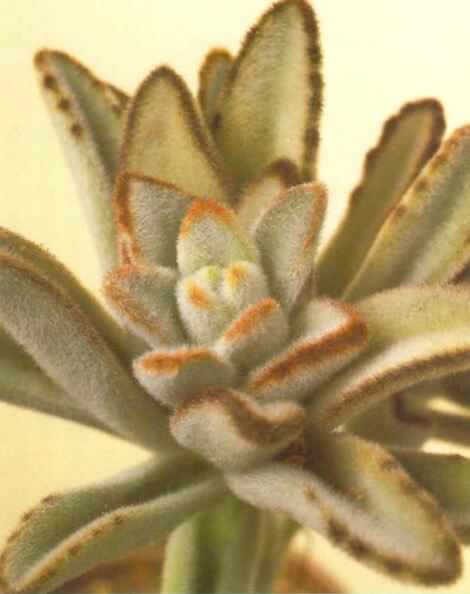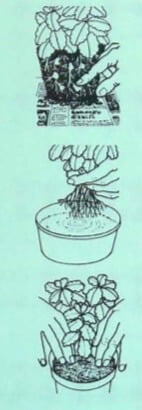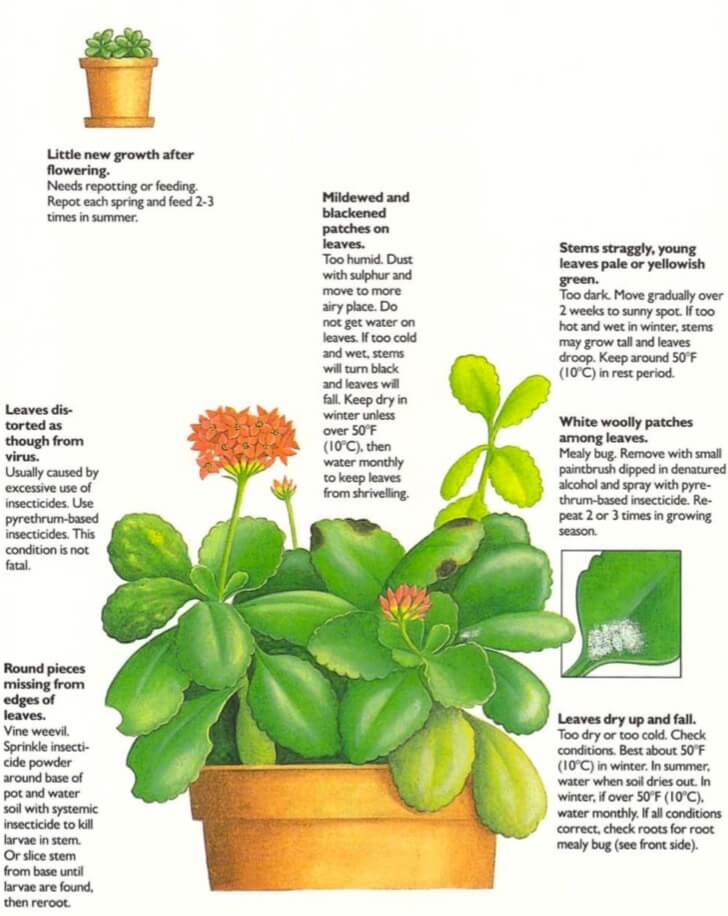[Ebook Việt Hoá] The Instant Guide to Healthy Houseplants (Hướng dẫn tức thời để chăm cây trong nhà khoẻ mạnh), Chi Kalanchoe
[Ebook Việt Hoá] The Instant Guide to Healthy Houseplants: Kalanchoe blossfeldiana (Kalanchoe)
- Nguồn: [Ebook Việt Hoá] The Instant Guide to Healthy Houseplants (Hướng dẫn tức thời để chăm cây trong nhà khoẻ mạnh)
- Biên tập: Dũng Cá Xinh
- Biên dịch: Team Codai.net
English
Brilliant clusters of small red, yellow or pink flowers and wide, fleshy, green leaves characterize this popular species. It grows up to 12 inches (30 cm) high and usually flowers from autumn until spring, although some can now be bought in flower at almost any time. Another good species is Kalanchoe tomentosa , also known as the panda plant (plush plant), with velvety, silvery green leaves with brown edges. Also available are K. rhombopilosa ancl K. fedtschenkoi, with lilac purple leaves, ancl K. tubiflora, which has tiny leaf- plantlets.

Light
Needs sunny conditions for best leaf color and good flowers.
Temperature
Minimum 45°F (7°C), most grow better at 50°F (10°C). Give fresh air in summer months.
Water
Water biweekly in spring and summer, weekly in hottest weather if soil dries out rapidly. Taper off in autumn and, if under 45°C (7°C), keep dry in winter. If at 50°F (10°C) or over, water one a month, just enough to keep leaves from shrivelling.
Feeding
Use high-potash fertilizer 2 or 3 times in summer.
Soil
Use good loam-based potting soil (or soilless mix) with 20 percent coarse, gritty sand.
Repotting
Transfer to size-larger pot every spring.
Propagation
Take whole shoots or leaf cuttings in spring or summer. Cut shoots with a sharp knife, ease leaves off gently wit as much of base as possible. Dust with hormone rooting powder, let dry for 3 days, the lay on fresh, dry soil. Water after 3 weeks, when roots should have formed. Some Kalanchoes (also called Bryophyllums) make little plantlets on the leaves. These may be taken off any time and treated in the same way.
Root mealy bug
- When repotting, check roots for root mealy bug (white woolly patches).
- If found, wash all soil off roots under a faucet and swirl in insecticide diluted to manufacturer’s instructions.
- Let dry for 2 – 3 days, when replant in fresh soil and clean pot. Do not water 2 – 3 weeks.

What Goes Wrong

- Little new growth after flowering: Needs repotting or feeding. Repot each spring and feed 2-3 times in summer.
- Mildewed and blackened patches on leaves: Too humid. Dust with sulphur and move to more airy place. Do not get water on leaves. If too cold and wet, stems will turn black and leaves will fall. Keep dry in winter unless over 50°F (10°C), t h e n water monthly to keep leaves from shrivelling.
- Leaves distorted as though from virus: Usually caused by excessive use of insecticides. Use pyrethrum-based insecticides. This condition is not fatal.
- Round pieces missing from edges of leaves: Vine weevil. Sprinkle insecticide powder around base of pot and water soil with systemic insecticide to kill larvae in stem. Or slice stem from base until larvae are found
- Stems straggly, young leaves pale or yellowish green: Too dark. Move gradually over 2 weeks to sunny spot. If too hot and wet in winter, stems may grow tall and leaves droop. Keep around 50°F (10°C) in rest period.
- White woolly patches among leaves: Mealy bug. Remove with small paintbrush dipped in denatured alcohol and spray with pyrethrum-based insecticide. Re- peat 2 or 3 times in growing then reroot.
- Leaves dry up and fall: Too dry or too cold. Check conditions. Best about 50°F (10°C) in winter. In summer, water when soil dries out. In winter, if over 50°F (10°C), water monthly. If all conditions correct, check roots for root mealy bug (see front side).
Tiếng Việt
Những cụm hoa nhỏ màu đỏ, vàng hoặc hồng rực rỡ và những chiếc lá rộng, nhiều thịt, màu xanh lá cây là đặc điểm của loài phổ biến này. Nó cao tới 12 inch (30 cm) và thường ra hoa từ mùa thu cho đến mùa xuân, mặc dù một số cây có thể mua về trồng hoa bất cứ lúc nào. Một loài tốt khác là Kalanchoe tomentosa, còn được gọi là cây gấu trúc, với những chiếc lá màu xanh bạc, mượt mà với viền màu nâu. Ngoài ra còn có K. rhombopilosa ancl K. fedtschenkoi, với lá màu tím hoa cà, ancl K. tubiflora, có lá nhỏ.

Ánh sáng
Cần điều kiện nắng để màu lá đẹp nhất và hoa tươi tốt.
Nhiệt độ
Tối thiểu 45 ° F (7 ° C), hầu hết phát triển tốt hơn ở 50 ° F (10 ° C). Cung cấp không khí trong lành trong những tháng mùa hè.
Nước
Tưới nước hai tuần một lần vào mùa xuân và mùa hè, hàng tuần khi thời tiết nóng nhất nếu đất khô nhanh. Héo vào mùa thu và nếu dưới 45 ° C (7 ° C), hãy giữ khô vào mùa đông. Nếu ở nhiệt độ 50 ° F (10 ° C) trở lên, hãy tưới nước mỗi tháng một lần, vừa đủ để giữ cho lá không bị teo.
Bón phân
Sử dụng phân bón có hàm lượng kali cao 2 hoặc 3 lần vào mùa hè.
Đất
Sử dụng đất bầu tốt làm từ mùn (hoặc hỗn hợp không đất) với 20% cát thô.
Thay chậu
Chuyển sang chậu có kích thước lớn hơn vào mỗi mùa xuân.
Nhân giống
Lấy toàn bộ chồi hoặc giâm lá vào mùa xuân hoặc mùa hè. Dùng một con dao sắc để dễ dàng cắt bỏ phần gốc càng nhiều càng tốt. Phủ lớp bột kích tố ra rễ, để khô trong 3 ngày, đặt trên đất khô và tươi. Tưới nước sau 3 tuần, khi rễ đã hình thành. Một số loài Kalanchoes (còn gọi là Bryophyllums) tạo ra những cây con nhỏ trên lá. Chúng có thể lấy ra bất kể lúc nào và chăm sóc bằng cách y hệt.
Rệp sáp rễ
- Khi thay chậu, kiểm tra rễ xem có rệp sáp hay không (các mảng lông tơ màu trắng).
- Nếu tìm thấy, hãy rửa sạch tất cả đất bám trên rễ dưới vòi nước và thêm thuốc diệt côn trùng được pha loãng theo hướng dẫn của nhà sản xuất.
- Để khô 2 – 3 ngày, khi trồng lại trồng vào đất sạch và chậu sạch. Không tưới 2 – 3 tuần.

Những vấn đề có thể xảy ra

- Phát triển ít sau khi ra hoa: Cần thay chậu hoặc bón phân. Thay chậu vào mỗi mùa xuân và bón phân 2-3 lần vào mùa hè.
- Các mảng bị mốc và đen trên lá: Quá ẩm. Thêm bột lưu huỳnh và di chuyển đến nơi thoáng mát hơn. Không để dính nước vào lá. Nếu quá lạnh và ẩm ướt, thân cây sẽ chuyển sang màu đen và lá bị rụng. Giữ khô ráo vào mùa đông trừ khi trên 50 ° F (10 ° C), tưới nước hàng tháng để giữ cho lá không bị teo.
- Lá méo mó như bị nhiễm vi rút: Thường do sử dụng quá nhiều thuốc diệt côn trùng. Sử dụng thuốc diệt côn trùng pyrethrum. Tình trạng này không gây chết cây.
- Mảnh tròn khuyết mép lá: Mọt. Rắc bột thuốc diệt côn trùng xung quanh gốc chậu và tưới nước có pha thuốc diệt côn trùng toàn thân để diệt ấu trùng ở thân. Hoặc cắt mỏng từ gốc cho đến khi tìm thấy ấu trùng.
- Thân cây khẳng khiu, lá non màu xanh nhạt hoặc vàng: Quá tối. Di chuyển dần dần trong 2 tuần tới chỗ có nắng. Nếu quá nóng và ẩm ướt vào mùa đông, thân cây có thể mọc cao và lá rũ xuống. Giữ khoảng 50 ° F (10 ° C) trong thời gian nghỉ.
- Các mảng lông tơ trắng giữa các lá: Rệp sáp. Loại bỏ bằng cọ nhỏ nhúng trong cồn biến tính và phun thuốc trừ sâu pyrethrum. Lặp lại 2 hoặc 3 lần trong quá trình phát triển sau đó trồng lại.
- Lá khô và rụng: Quá khô hoặc quá lạnh. Kiểm tra các điều kiện. Tốt nhất là khoảng 50 ° F (10 ° C) vào mùa đông. Vào mùa hè, tưới nước khi đất khô đi. Vào mùa đông, nếu trên 50 ° F (10 ° C), hãy tưới hàng tháng. Nếu tất cả các điều kiện đều đúng, hãy kiểm tra rễ để tìm rệp sáp (xem mặt trước).
![[Ebook Việt Hoá] The Instant Guide to Healthy Houseplants: Kalanchoe blossfeldiana (Kalanchoe) [Ebook Việt Hoá] The Instant Guide to Healthy Houseplants: Kalanchoe blossfeldiana (Kalanchoe)](https://vn1.vdrive.vn/codai.net/2020/02/ebook-huong-dan-tuc-thoi-cham-cay-trong-nha-khoe-manh-114-kalanchoe-blossfeldiana.jpg)


